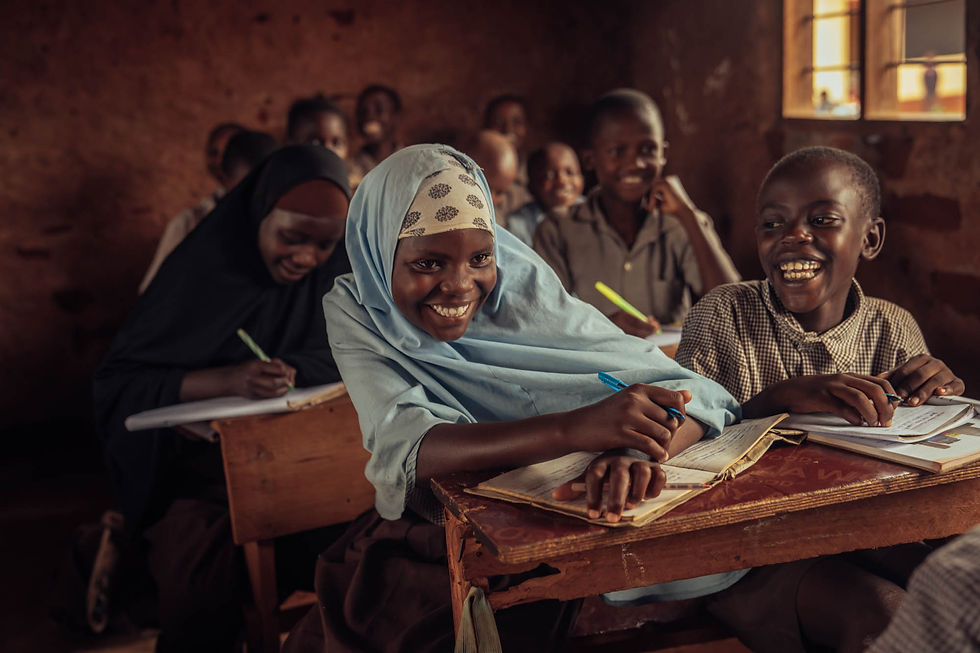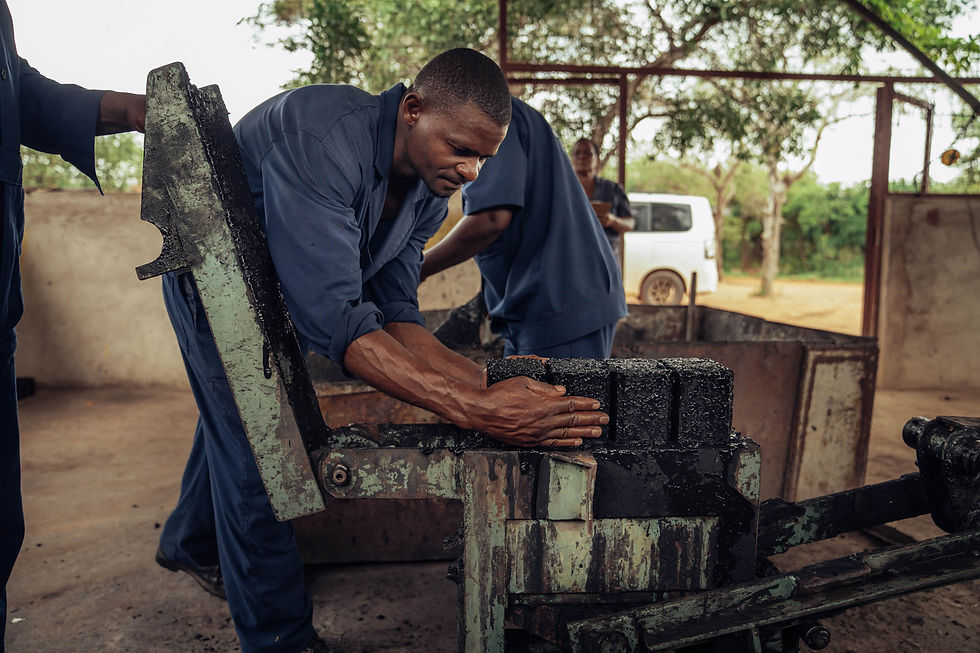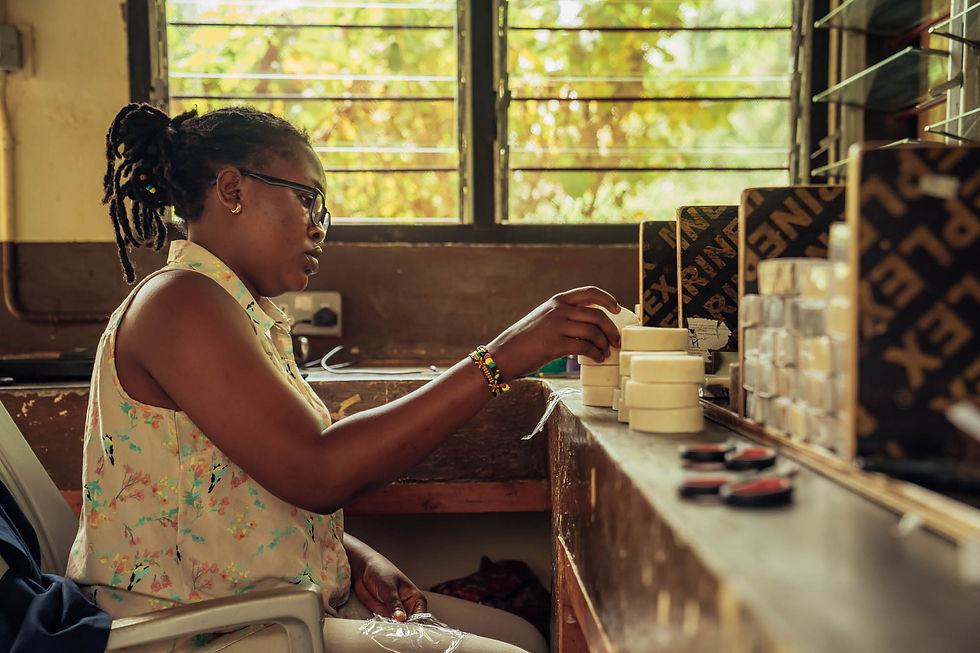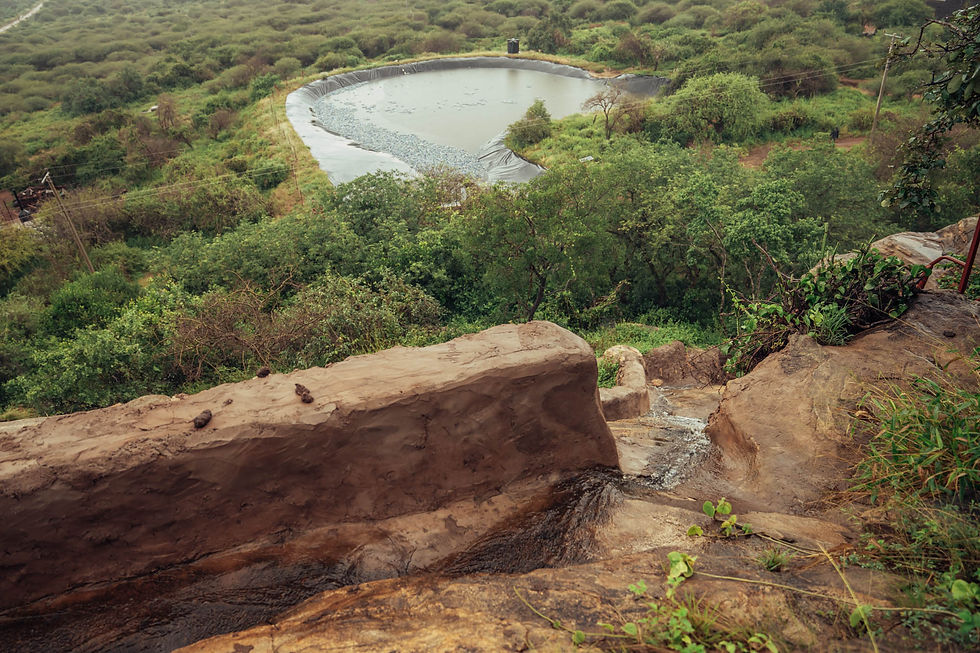WATCH
In Kasigau, through the Wildlife Works REDD+ project, we have a way to take care of the forest and help humans co-exist with wildlife. Through REDD+ work, we are able to fund what we need like education, access to clean water, and clinics. From the scholarships, students have gone out to learn, and are now coming back to the community as teachers, nurses, doctors, and business owners.
>100k
COMMUNITY
PARTNERS

200k
HECTARES
OF FOREST PROTECTED

11
ENDANGERED
SPECIES PROTECTED

1.8m
tCO2e EMISSIONS
AVOIDED PER YEAR

ABOUT THE KASIGAU CORRIDOR REDD+ PROJECT
The Kasigau Corridor REDD+ project is the world’s first and longest standing certified REDD+ (Reducing Emissions from Deforestation and Degradation) project.
WATER IS LIFE
At the Kasigau Corridor REDD+ project in Kenya, community members are investing carbon revenue into improving access to water for all.
PORTRAIT OF A RANGER: CONNIE
At the Kasigau Corridor REDD+ project in Kenya, Connie Mwandaa has helped pave the way for female rangers.
-Joseph Mwakima
WILDLIFE WORKS COMMUNITY RELATIONS OFFICER
OVERVIEW
The Kasigau Corridor REDD+ project is the world’s first and longest standing certified REDD+ (Reducing Emissions from Deforestation and Degradation) project. With community self-governance and sustainable job creation at the heart of the project’s strategy, it addresses the threats of poaching and deforestation by partnering with over 100,000 community members to drive investments in health, education, clean water, economic opportunities, and direct job creation. A critical wildlife corridor between Tsavo East and West National Parks, the Kasigau Corridor REDD+ Project protects over 200,000 hectares of dryland forest for a diverse population of endangered wildlife. In an area where wildlife and human survival were once at odds, the Kasigau Corridor REDD+ project has transformed the paradigm through a unique, market-based solution to wildlife conservation.

KASIGAU, KENYA
REDD+ PROJECT SPECIFICS
START DATE:
KASIGAU CORRIDOR PHASE I: 2005
KASIGAU CORRIDOR PHASE 2: 2010
DURATION: 30 YEARS
PROJECT TYPE: AVOIDED DEFORESTATION REDD+
METHODOLOGY: VM0009
REGISTRY: VERRA
THIRD-PARTY VERIFIED ☑
PROJECT FAQ
FOR DETAILS INCLUDING THE PROJECT BASELINE AND REFERENCE AREA.
READ THE FULL PROJECT FAQ FOR DETAILS INCLUDING THE PROJECT BASELINE AND REFERENCE AREA.
IMPACT
HIGHLIGHTS










36 SCHOOLS RENOVATED, 10 NEW SCHOOLS BUILT, AND OVER 30,000 SCHOLARSHIPS AWARDED.
OVER 400 LOCALLY HIRED EMPLOYEES, 1/3 OF WHOM ARE WOMEN
1,700 WOMEN PARTICIPATING IN THE HANDI CRAFT VENTURE THAT GENERATED $250,000 IN REVENUE IN 2021
OVER 50 CLEAN WATER AND WATER CONSERVATION PROJECTS COMPLETED
DIAGNOSTIC HEALTH LABORATORY RENOVATED AND AFTER-SCHOOL HEALTH EDUCATION PROGRAMS ESTABLISHED FOR >1200 STUDENTS
KASIGAU CORRIDOR REDD+ PROJECT CONTRIBUTES TO 13 SDGs


The Kasigau Corridor project area is home to over 100,000 forest community members dispersed across 6 towns.
The Kasigau Corridor REDD+ project area is home to over 100,000 people. The majority of the region is home to people who identify as Taita. The Taita consist of 3 subgroups: the Wadawida, the Wasaghalla, and the Wataveta, all who are thought to have originally migrated to the area around 1000-1300 CE.
Traditionally, the Taita lived in the hills, close to water sources. This enabled peaceful coexistence between the large wildlife populations that roamed the plains below.
Traditional economic activities included hunting, livestock rearing, and subsistence agriculture (with crops such as sorghum, millet, and yams). As populations grew and competition for resources intensified, many Taita migrated into the plains below, resulting in increased conflict with the wildlife that roams these plains.
The Kasigau Corridor REDD+ project sits right along the famous Mombasa-Nairobi railway, which slices through the heart of the greater Tsavo ecosystem. Being so close to this important trade route, the communities in this area have lived through the slave trade, British colonialization, WWII, and the Mau Mau rebellion.

ECO-CHARCOAL PRODUCTION
Learn more
Charcoal production can be extremely detrimental to the environment, as it requires 10 tons of wood to produce 1 ton of charcoal. Our sustainable charcoal team has produced tens of thousands of kgs of eco-charcoal without cutting down a single tree and are developing sales channels to increase its distribution. Eight permanent staff manually process 850-1,274 0.5kg briquettes/week.

COMMUNITY GOVERNANCE
Learn more
The Locational Carbon Committees (LCCs) are the governance structure through which the communities directly allocate carbon revenue towards community driven initiatives. The LCCs are democratically elected and approve budget spending on various community projects.

EQUALITY IN EDUCATION
Learn more
In addition to funding scholarships and school infrastructure, communities have chosen to use carbon revenue to fund a after-school health education programs. In 2021, a pilot program was rolled out in 10 primary schools across the project area, which combined the gender-inclusive sport of volleyball with reproductive health education. Subjects covered, for both boys and girl, include gender-based violence, menstruation, STIs and HIV.

SUSTAINABLE JOBS
Learn more
The project supports basket weaving women's groups in the project zone, as well as the production of other eco-crafts such as soaps and clothing, to strengthen women's economic opportunities, connecting them to external markets, building capacity and improving product quality of local craft groups.

CONSERVATION FARMING
Learn more
Our organic greenhouse distributes seedlings to the community for reforestation and community gardens. Carbon revenue also funds water access and sustainable farming training.

WATER CONSERVATION
Learn more
Carbon revenues have funded the completion of water infrastructure projects (rain catchments, pipes, etc.) that improve access to clean water for over 100,000 people.
COMMUNITY STORIES

THE COMMUNITY PARTNERS
.webp)
° Loxodonta africana
AFRICAN SAVANNAH ELEPHANT
African savanna elephants, the largest land animals on our planet, are also some of the most awe-inspiring. Their incredible memories help them remember key foraging areas as they migrate across the savannahs. Their emotional intelligence and empathy keep their close-knit social groups strong in the face of adversity. They have rich social lives, complete with moments of joy and mourning periods (or “elephant funerals”) when members of their herd die. African elephants are known as “ecosystem engineers” because they create unique habitats for other species by physically altering the environment. Just through their massive footprints, they create small ponds for frogs. They also help to fertilize the soil and spread the seeds of plants that they eat, contributing positively to the life cycle of the ecosystem. Human-wildlife conflict is now one of the top threats to Savanna elephants across Africa, whose populations have decreased by at least 60% over the last 50 years, according to the latest IUCN assessments. Climate change related drought is also an emerging threat to elephants: Kenyan wildlife officials recently reported that drought now kills 20x more elephants than poaching, with 179 elephants succumbing to dehydration in just the first half of 2022. An estimated 11,000 elephants use the corridor as a key migratory route, and over 2,000 elephants use the space as a permanent home.
.webp)
° Giraffa tippelskirchi
MAASAI GIRAFFE
Giraffes, the silent giants of the savannah, are pivotal to the health of the ecosystem at our Kasigau Corridor project. With their 6 foot long necks, giraffes feed on and prune the top browse of the iconic, thorny Acacia trees. In this way, giraffes don’t compete with other smaller herbivores for food, and open up the canopy so that plants below can receive more light. In reciprocation, giraffes help spread acacia seeds across the savannah as they migrate. In the last 30 years, giraffe populations across Africa have decreased by over 40% and there are now only around 100,000 giraffes left in Africa. Climate change related droughts, habitat loss and fragmentation, trophy hunting and poaching for giraffe skins and tails are all contributing factors to their decline.

° Panthera leo
LION
Lions are apex predators, and perform the critical job of managing herbivore populations. Without lions, ecosystems become unbalanced, and unchecked populations of zebras, gazelles, and antelopes inevitably overgraze grasslands, leading to habitat degradation. By going after the weakest members of the herd (often those carrying parasites, disease, or genetic defects) lions help to maintain healthy, resilient populations and prevent the spread of disease. Despite this importance, lion populations continue to dwindle globally due to poaching and habitat loss caused by human activities. Worldwide, there are only an estimated 30-40,000 mature lions left in Africa, and they are listed as Vulnerable to extinction on the IUCN. At any given time, there are 15-30 lions in our project area.
.webp)
° Gyps africanus
WHITE BACKED VULTURE
The White-backed vulture, a critically endangered species at our protected area in Kenya, is critical to maintaining ecosystem health. It may not be the most glamorous of jobs, but as the “garbage men'' of the Savannas, vultures remove toxins from the environment that are harmful to both humans and other species. Despite this importance, 70% of all African vulture species are endangered. Certain medications for cattle, such as Diclofenac, are poisonous to vultures who eat their remains. Vultures are also sometimes intentionally poisoned by poachers who don’t want the flock of birds to give away the location of an illegally killed animal. The loss of vultures ricochets through the food web and detrimentally affects many species, including humans. Without vultures, other scavengers like rats and feral dogs can fill their ecological niche, which leads to harmful diseases being transmitted back to, and in some instances, killing humans. In the case of vultures, it is clear that wildlife works to maintain ecosystem and human health. In partnership with local communities, we are committed to protecting endangered vulture species and the Kasigau Corridor they inhabit.
FOCAL
WILDLIFE SPECIES
The project area is now home to an incredibly diverse population of wildlife including more than 300 species of birds, 20 species of bats, and over 50 species of large mammals including critical populations of IUCN Red List species such as the Grevy's Zebra and African Wild Dog.
The Kasigau Corridor is composed of over 200,000 hectares of dryland Acacia-Commiphora forest
Many community members rely on Acacia and Commiphora trees to create charcoal, which is then used to cook meals. Our eco-charcoal factory now helps sustainably create charcoal without cutting down trees, and currently produces around a thousand 0.5kg briquettes/ week .
The incredible baobab tree (also known as the Tree of Life) dots the endless horizons of the Kasigau Corridor. As the world’s largest succulent, it can also store over 1000 gallons of water in its trunk and can live for over a thousand years. The baobab tree helps provide shade and critical habitat for wildlife, and is important to the cultural traditions of the local community.

THE FOREST
MAI NDOMBE
DRC
In the Democratic Republic of the Congo (DRC), the Mai Ndombe REDD+ project protects 300,000 hectares of tropical rainforest.
PACIFIC ECOREGION
COLOMBIA
In the Pacific Coastal Ecoregion of Colombia, we have 3 projects in development to protect 500,000 hectares of forest.
EXPLORE OUR OTHER PROJECTS

BUY KASIGAU CORRIDOR REDD+ PROJECT CARBON CREDITS
Ready to make a real difference? Purchase carbon credits to invest directly in the Kasigau Corridor REDD+ Project in Kenya, the world’s first and longest-standing certified REDD+ initiative. Each carbon credit purchase means one metric ton of carbon emissions prevented by protecting forests.
$20 per credit.
THREATS TO THE FOREST
The Kasigau Corridor serves as a critical wildlife corridor between the two halves of Kenya’s largest national park: Tsavo East and Tsavo West.
In the late 1990’s, the dry-land forest of the Kasigau Corridor had become degraded by a combination of factors including cattle overgrazing, clear cutting of trees for charcoal and illegal hunters easily accessing the unprotected land. Centuries of exploitation and marginalization had pushed these community members to a breaking point, and their pursuit to meet their basic needs led to the destruction of the very environment they relied on.
Without sustainable livelihood alternatives, poaching, clear-cutting for subsistence agriculture and production of charcoal, and unsustainable cattle grazing are still key drivers of biodiversity loss, deforestation, forest degradation in the area.
Prolonged drought seasons caused by global warming are also making grassland fires an increasing threat.
PROJECT STRATEGY
With this foundational project, Wildlife Works broke the mold of the traditional (and failing) fortress model of conservation, and pioneered a new method of conservation: one that places communities at the center of decision making. The goal of this project was to alleviate pressure on the ecosystem through job creation.
To protect the forest and earn revenue from carbon credit sales, we partner with the local community of the Kasigau Corridor region to co-create long-term jobs that replace the unsustainable sources of income such as poaching, subsistence farming, and illegal tree harvesting. This includes jobs that protect wildlife, create eco-friendly products, support education, and co-develop conservation agriculture techniques with farmers.
Through an innovative model of community governance, the communities of Kasigau establish their own priorities for utilizing carbon revenue, resulting in sustained investments in scholarships for children, school infrastructure, water infrastructure, and other programs to improve the economy, health, and well-being of the community. Learn more about the impacts, community, wildlife, and forest of this project in the sections below. For detailed information on the verification, third-party validation, and historic issuances of this project, see the Useful Links section.








